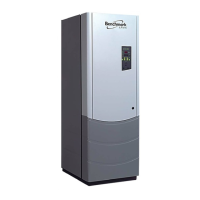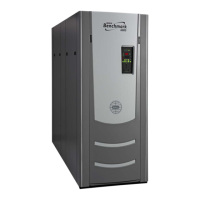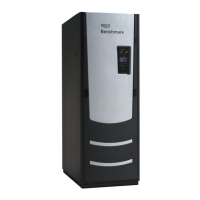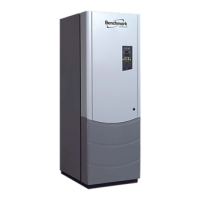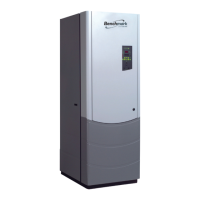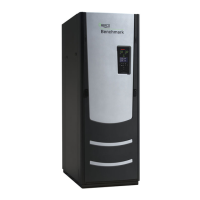TROUBLESHOOTING
3. Once flame is established, a steady reading
of greater than 1.25 VDC should be
observed on the voltmeter.
4. Fire the unit at various firing rates (i.e., 20%,
30%, 50%, 100% etc
,).
5. If flame signal is erratic at a particular firing
rate or range of firing rates, check
combustion calibration as per Sections 4.3,
and 4.4 of this manual.
8.5.2 FLAME FAULT DURING IGNITION
TRIAL
1. Check that all gas supply valves are open
2. If the gas supply valves were open, start the
unit.
3. Remove the cover to the air/fuel valve.
Ensure that the air/fuel valve rotates to the
ignition position and engages the ignition
position switch. If the air/fuel valve does not
rotate to the ignition position proceed to
Section 8.7.7.
4. If the air/fuel valve rotates and engages the
ignition position switch during the trial for
ignition then visually watch/inspect the
safety shut-off valve, through the window on
the actuator half to determine if it is opening.
NOTE:
At the ignition cycle, the low fire switch is
made, and the safety shut-off valve is
energized. The OPEN disk in the safety
shut-off valve actuator window should
slowly move downward indicating that the
valve is operating correctly. If the valve
does not open proceed to Section 8.5.3
5. If the safety shut-off valve opens check the
spark ignitor as per Section 8.4.4 and the
flame detector, as per Section 8.4.5.
6. If the spark ignitor and flame detector are
okay, or require replacement and the flame
fault still persists, check the ignition circuit
as per Section 8.4.6.
7. If the flame fault still persists after checking
the above, measure the flame detector lead
voltage as per Section 8.4.7.
8. If the flame fault still persists after checking
all of the above, remove the burner and
inspect for debris.
If the flame fault still persists after the above,
replace the combustion safeguard.
8.5.3 SAFETY SHUT-OFF VALVE
1. Start the unit.
2. When the starting sequence reaches the
ignition trial cycle, observe the response of
the safety shut-off valve through the window
in the actuator portion
3. At the ignition cycle, the OPEN disc should
slowly begin to descend down as the
hydraulic actuator opens the valve.
4. If the actuator does not open the valve,
disconnect AC power to the unit.
5. Remove the actuator portion from the valve
body and inspect for signs of leaking
hydraulic fluid.
6. If the actuator is not leaking, set it back on
the valve body and remove the electrical
cover plate exposing the control wiring.
7. Temporarily secure the actuator to the valve
body with the control wiring facing outward
for easy access.
8. Referring to system schematic 161453 in
Appendix H, connect an AC voltmeter
across wires #145 and #146.
9. Reconnect AC power to the unit.
10. Start the unit.
11. At the ignition trial cycle 120VAC should be
observed on the AC voltmeter.
12. If 120VAC is observed on the voltmeter,
replace the safety shut-off valve actuator.
13. If 120VAC is not observed on the AC
voltmeter, disconnect AC power to the unit.
14. Disconnect the 1” diameter connector from
the control panel, and remove the cover
from the AC wiring box.
15. Referring to system schematic 161453 in
Appendix H, locate wires #145 #146 and
#147 and check each for continuity.
16. Check each wire for loose connectors at the
safety shut-off valve end. Check wires #145
#146 and #147 for loose connectors in the
Benchmark Control Box.
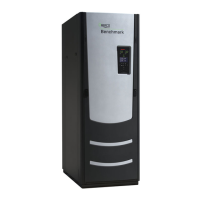
